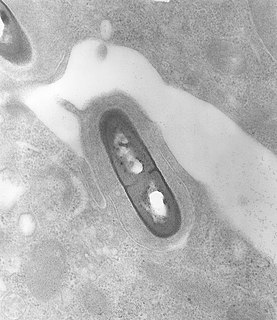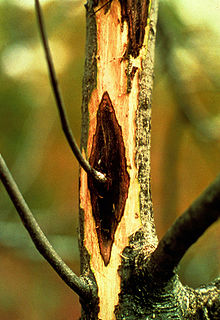
Listeria monocytogenes is the species of pathogenic bacteria that causes the infection listeriosis. It is a facultative anaerobic bacterium, capable of surviving in the presence or absence of oxygen. It can grow and reproduce inside the host's cells and is one of the most virulent foodborne pathogens: 20 to 30% of foodborne listeriosis infections in high-risk individuals may be fatal. Responsible for an estimated 1,600 illnesses and 260 deaths in the United States annually, listeriosis ranks third in total number of deaths among foodborne bacterial pathogens, with fatality rates exceeding even Salmonella spp. and Clostridium botulinum. In the European Union, listeriosis follows an upward trend that began in 2008, causing 2,161 confirmed cases and 210 reported deaths in 2014, 16% more than in 2013. Listeriosis mortality rates are also higher in the EU than for other foodborne pathogens.

Listeria is a genus of bacteria that acts as an intracellular parasite in mammals. Until 1992, 10 species were known, each containing two subspecies. By 2020, 21 species had been identified. The genus is named in honor of the British pioneer of sterile surgery Joseph Lister. Listeria species are Gram-positive, rod-shaped, and facultatively anaerobic, and do not produce endospores. The major human pathogen in the genus Listeria is L. monocytogenes. It is usually the causative agent of the relatively rare bacterial disease listeriosis, an infection caused by eating food contaminated with the bacteria. Listeriosis can cause serious illness in pregnant women, newborns, adults with weakened immune systems and the elderly, and may cause gastroenteritis in others who have been severely infected.

A plant canker is a small area of dead tissue, which grows slowly, often over years. Some cankers are of only minor consequence, but others are ultimately lethal and therefore of major economic importance in agriculture and horticulture. Their causes include such a wide range of organisms as fungi, bacteria, mycoplasmas and viruses. The majority of canker-causing organisms are bound to a unique host species or genus, but a few will attack other plants. Weather and animals can spread canker, thereby endangering areas that have only slight amount of canker.
Alteromonas is a genus of Proteobacteria found in sea water, either in the open ocean or in the coast. It is Gram-negative. Its cells are curved rods with a single polar flagellum.
Cedecea is a genus of extremely rare bacteria of the family Enterobacteriaceae. The name of this genus was derived from CDC, the abbreviation for the Centers for Disease Control where the initial members of this genus were discovered. This genus resembles no other group of Enterobacteriaceae. Cedecea bacteria are Gram-negative, bacillus in shape, motile, nonencapsulated, and non-spore-forming. The strains of Cedecea appear to be similar to those of Serratia. Both Cedecea and Serratia are lipase positive and resistant to colistin and cephalothin; however, Cedecea is unable to hydrolyze gelatin or DNA.
Dactylosporangium is a genus in the phylum Actinobacteria (Bacteria).
Listeria ivanovii is a species of bacteria in the genus Listeria. The listeria are rod-shaped bacteria and become positively stained when subjected to Gram staining. Of the six bacteria species within the genus, L. ivanovii is one of the two pathogenic species. It behaves like L. monocytogenes, but is found almost exclusively in ruminants. The species is named in honor of Bulgarian microbiologist Ivan Ivanov.
Acinetobacter junii is a species of bacteria. Its type strain is ATCC 17908. It can be pathogenic. This bacterium has been linked to nosocomial infections including catheter-related blood stream infections and cellulitis.
Citrobacter farmeri is a Gram-negative species of bacteria.
Citrobacter youngae is a Gram-negative species of bacteria.
Citrobacter werkmanii is a Gram-negative species of bacteria.
Listeria marthii is a species of bacteria. It is a Gram-positive, motile, facultatively anaerobic, non-spore-forming bacillus. It is non-pathogenic, and non-hemolytic. The species was first isolated from Finger Lakes National Forest in New York. It is named after Elmer H. Marth, a researcher of L. monocytogenes, and was first published in 2010. L. marthii was the first new species of Listeria proposed since 1985.
Listeria rocourtiae is a species of bacteria. It is a Gram-positive, facultatively anaerobic, motile, non-spore-forming bacillus. It is non-pathongenic and non-hemolytic. The species was first isolated from pre-cut lettuce in Salzburg, Austria in 2002. It is named in honor of Jocelyne Rocourt, "whose work had a major impact on the taxonomy of the genus Listeria."
Streptococcus infantarius is a species of bacteria.
Streptomyces cellulolyticus is a cellulolytic bacterium species from the genus of Streptomyces.
Listeria welshimeri is a species of bacteria. It is a Gram-positive, facultatively anaerobic, motile, non-spore-forming bacillus. It is non-pathogenic and non-hemolytic. It was isolated from decayed vegetation in the United States by H. J. Welshimer, after whom the species is named. The species was first proposed in 1983.
Listeria grayi is a species of bacteria. It is a Gram-positive, facultatively anaerobic, motile, non-spore-forming bacillus. It is non-hemolytic. The species was first proposed in 1966. It is named after M.L. Gray, an early researcher in L. monocytogenes There are two subspecies of L. grayi: L. gray subs. grayi, and L. grayi subsp. murrayi.
Buttiauxella agrestis is a bacterium from the genus of Buttiauxella which has been isolated from soil. Buttiauxella agrestis can cause surgical site infections
Janibacter is a genus of Gram positive, nonmotile, non-sporeforming bacteria. The genus name is derived from the two-faced Roman god Janus, referring to the fact that the cells of the original strain could be rod-shaped or coccoid.
Listeria innocua is a species of Gram-positive, rod-shaped bacteria. It is motile, facultatively anaerobic, and non-spore-forming. L. innocua was named innocua (innocuous) because, in contrast to Listeria monocytogenes, it does not readily cause disease in mammals. Another Listeria species, L. seeligeri, was named after one of the discoverers of L. innocua.


